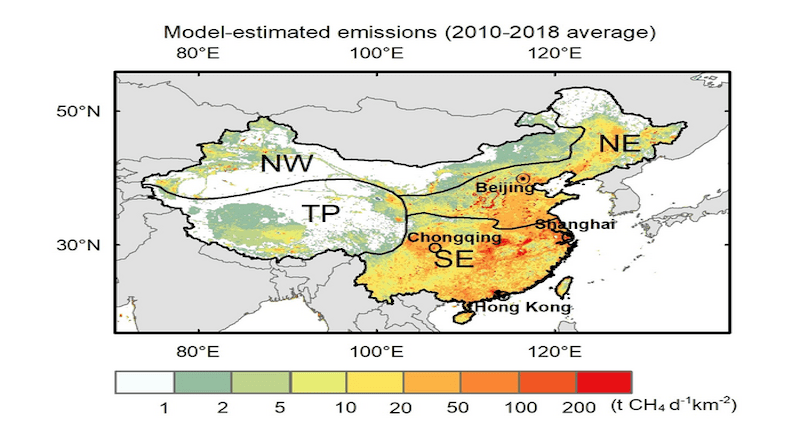Model Analysis Of Atmospheric Observations Reveals Methane Leakage In North China
Background
Natural gas is a relatively clean burning fossil fuel, that causes less air pollution than coal and is widely used in the world. Recent studies have shown that the natural gas leaks from production, supply chain, and end-use facilities are a large source of atmospheric methane (CH4), and the leaking budget is underestimated in many places by bottom-up inventories. CH4 is the second most important greenhouse gas (GHG) contributing to global warming after carbon dioxide (CO2), with a relatively shorter lifetime, making the reduction of CH4emission a suitable target for implementing rapid and achievable mitigation strategies of the Paris Agreement.
Over the last decade, natural gas has become the fastest-growing fossil energy source in China due to the coal-to-gas government initiative that has been implemented to reduce air pollution and CO2 emissions. Natural gas consumption has increased dramatically from 108.5 billion standard cubic meters (bcm) (4% of primary energy consumption) in 2010 to a record level of 280 bcm (7.6% of primary energy consumption) in 2018. In addition, according to China’s energy plan, the share of primary energy from gas will keep increasing and is likely to reach 15% by 2030, while coal and oil consumption will decline. From 2010 to 2018, the length of gas supply pipelines in urban areas of China increased approximately three-fold from 298 to 842 thousand kilometers. However, CH4 leakage from those pipelines has not been actively reported, and there is limited publicly available data on upstream emissions and local distribution of natural gas emissions in China.
Research Outline and Results
In this study, we used nine years (2010–2018) of CH4 observations by the Greenhouse gases Observing SATellite “IBUKI” (GOSAT) and surface station data from the World Data Centre for Greenhouse Gases (WDCGG) to estimate CH4 emissions in different regions of China. GOSAT observes the column-averaged dry-air mole fractions of CH4 in the atmosphere, and the surface stations monitor CH4 concentrations near surface. The observation data were used for simulations by the high-resolution inverse model NTFVAR (NIES-TM-FLEXPART-variational) to infer the surface flux of CH4 emissions. Inverse modelling optimizes prior flux estimates, which are constrained so that an acceptable agreement between the simulated and observed atmospheric concentrations is achieved.
The four regions, North China (NE), South China (SE), North-west China (NW), and the Qinghai-Tibetan Plateau (TP), vary with respect climate, geographical features, types of agriculture, major economic activities, and CH4 emission sources. The model-estimated average CH4 emissions from the four subregions over the period 2010–2018 are 30.0±1.0 (average ± standard deviation) Tg CH4 yr-1 from the SE region, 23.3±2.7 Tg CH4 yr-1 from the NE region, 2.9±0.2 Tg CH4 yr-1 from the NW region, and 1.7±0.1 Tg CH4 yr-1 from the TP region. The trends in CH4 emissions have varied in the different regions of China over the last nine years, with significant increase trends detected in the NE region and the whole China.
We focused our analysis on the NE region where natural gas production and consumption have increased dramatically and are likely one of the main contributors to the increase estimated in regional total CH4 emissions. The CH4 emissions from natural gas, including leakage from fuel extraction, processing, transport, and the end-use stage, were estimated using an approach that combined data for the province-level emissions inventory and published inverse model studies. The model-estimated total CH4 emissions and the estimated natural gas emissions both increased significantly during 2010–2018. The total amount of natural gas emissions due to leakages constitutes a significant waste of energy and value. For example, in 2018, natural gas consumption in the NE region was 101.5 bcm and the estimated total natural gas emissions were 3.2%–5.3% of regional consumption.
The year-over-year change in the model-estimated total CH4 emission closely follows the changes in CH4 emissions from natural gas. In January 2016, record cold wave hit the region causing a sudden increase in natural gas use, and natural gas suppliers recorded an increase in natural gas loss (i.e., the difference between the amount of gas purchased and the amount of gas sold). Simultaneously, the atmospheric observations also captured the emission changes, as reflected in our inverse estimates. The analysis shows a strong correlation between trends in natural gas use and the increase in the atmospheric CH4 concentration over the NE region, which is indicative the ability of GOSAT to monitor variations in regional anthropogenic sources.
Future Perspectives
The findings of our study highlight that the increase in natural gas use threatens China’s carbon reduction efforts. The increase in CH4 leaks from natural gas production and the supply chain will adversely affect the interests of diverse stakeholders, despite the introduction of carbon reduction measures.
Given that the large natural gas distribution pipelines span more than 900 thousand kilometers in China, natural gas leaks constitute a significant waste of energy and value. The year-over-year changes in regional emissions and trends were detected by satellite and surface observations in this study. In the future, additional observations using high-resolution satellites will help to more accurately quantify emissions and provide scientific directions for emission reduction measures. There is also a need to further detect and locate such leaks using advanced mobile platforms in order to effectively mitigate CH4 emissions in China and bring about economic, environmental, and health benefits.

